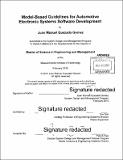| dc.contributor.advisor | Dov Dori. | en_US |
| dc.contributor.author | Quezada Gomez, Juan Manuel | en_US |
| dc.contributor.other | System Design and Management Program. | en_US |
| dc.date.accessioned | 2015-12-16T16:35:37Z | |
| dc.date.available | 2015-12-16T16:35:37Z | |
| dc.date.copyright | 2015 | en_US |
| dc.date.issued | 2015 | en_US |
| dc.identifier.uri | http://hdl.handle.net/1721.1/100383 | |
| dc.description | Thesis: S.M. in Engineering and Management, Massachusetts Institute of Technology, Engineering Systems Division, System Design and Management Program, 2015. | en_US |
| dc.description | Cataloged from PDF version of thesis. | en_US |
| dc.description | Includes bibliographical references (pages 96-98). | en_US |
| dc.description.abstract | The automobile innovation transformed the human life style ever since its introduction to the public, and for over the last one hundred years incumbent technologies have been adopted to improve its performance characteristics. Yet, we need a holistic approach to understand that automobiles shifted from being a mere assembly of mechanical parts to a multidisciplinary system that form the modern automobile. Thanks to the increased use of electronics and software in automobiles, consumers benefit from better gas mileage, more amenities and features, such as comfort, driving assistance, and entertainment. At the same time, stability and performance of automobiles as systems have been facing deterioration, and eventually vehicle owners are finding that features and functions become inoperative over time, causing frustration, loss of time and money. Reports of problems experienced by vehicle owners have stem from casual factors of system defects that model-based systems engineering can reduce or eliminate. This research presents a model-based systems engineering approach to an automobile electronic system design. The work is founded on a comprehensive OPM model and engineering guidelines for electronic control module software design. The purpose of the framework developed in this study is to support development of complex vehicle software that allows flexibility for changing features and creating new ones, and enables software developers to pinpoint systemic faults quicker and at earlier lifecycle phases, reducing rework, increasing safety, and providing for more effective resolution of such problems. | en_US |
| dc.description.statementofresponsibility | by Juan Manuel Quezada Gomez. | en_US |
| dc.format.extent | 104 pages | en_US |
| dc.language.iso | eng | en_US |
| dc.publisher | Massachusetts Institute of Technology | en_US |
| dc.rights | M.I.T. theses are protected by copyright. They may be viewed from this source for any purpose, but reproduction or distribution in any format is prohibited without written permission. See provided URL for inquiries about permission. | en_US |
| dc.rights.uri | http://dspace.mit.edu/handle/1721.1/7582 | en_US |
| dc.subject | Engineering Systems Division. | en_US |
| dc.subject | System Design and Management Program. | en_US |
| dc.title | Model-based guidelines for automotive electronic systems software development | en_US |
| dc.type | Thesis | en_US |
| dc.description.degree | S.M. in Engineering and Management | en_US |
| dc.contributor.department | System Design and Management Program. | en_US |
| dc.contributor.department | Massachusetts Institute of Technology. Engineering Systems Division | |
| dc.identifier.oclc | 932073230 | en_US |
